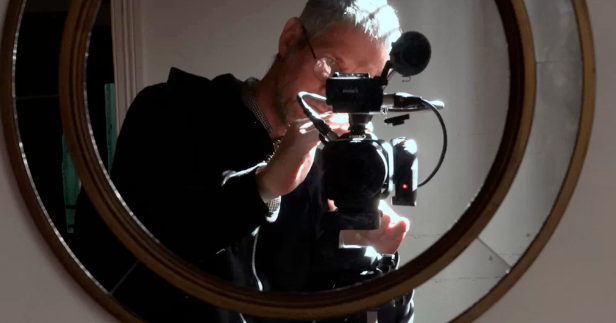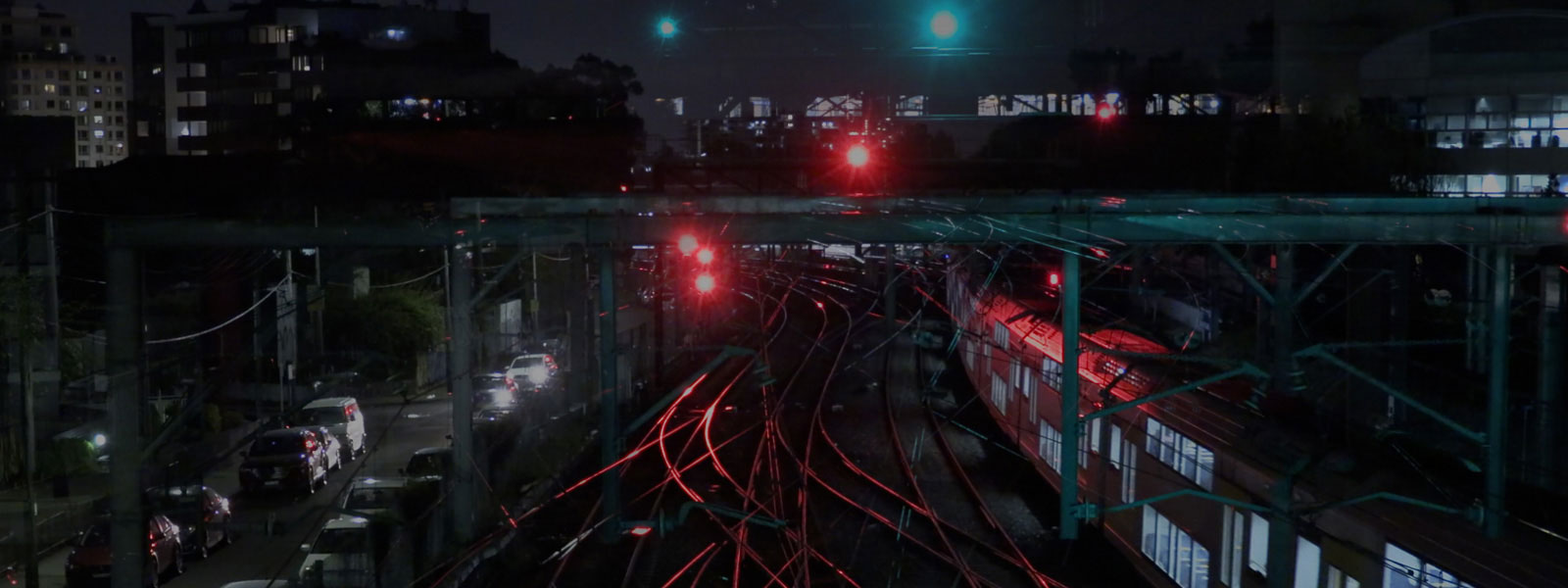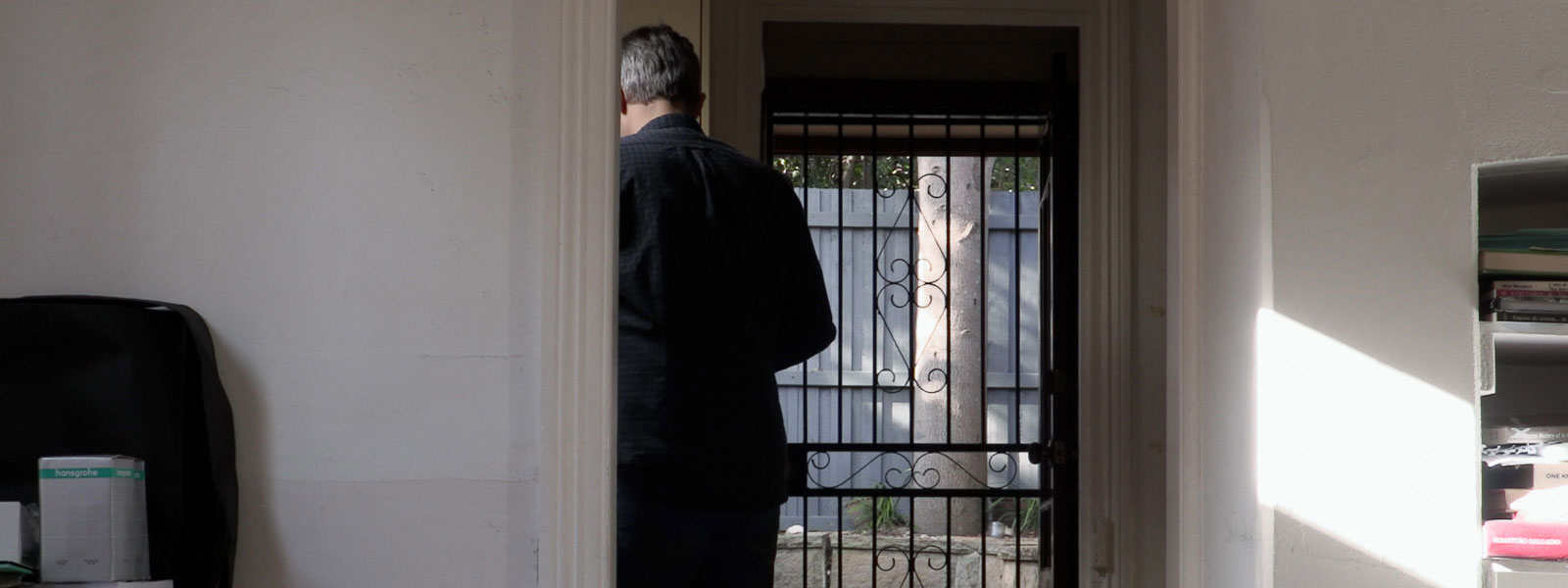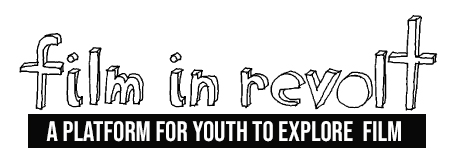by Flynn Boffo

Radio National’s ‘The Screen Show’ and its host, Jason Di Rosso was my introduction to film criticism. With his weekly show, my eyes were opened to the wider world of international cinema. Consequently, Jason played an important role in the path that has led me to this moment where you are reading my writing. Upon discovering that he was releasing a film of his own this year, I felt compelled to reach out.
The Hidden Spring is an essay film, exploring both the physical and spiritual distance between a terminally ill father and his son. It is the distance itself that Di Rosso candidly frames, reflecting on his father in Perth as he observes life changes around him in Sydney.
One thing that struck me about The Hidden Spring was its sense of reflection, filmed mostly within Jason’s inner west home. The familiar sounds of planes and trains are never far away, this motif of transport and the tracks connecting destinations are deeply embedded into Jason’s immigrant background.
Flynn Boffo: I am interested in learning more about the moment when you felt motivated to actually pick up a camera and start filming this.
Jason Di Rosso: It was just so intuitive, I was experiencing this initial shock and feeling of grief, anticipating my father’s decline. I was also doing a research doctorate at UTS, part of which was going to be some kind of film, and I had to in some way trust intuition and see what was going to emerge.
So that’s how the film really emerged. I started to get a sense that there’s a potential language here that will work for a film dealing with these themes, like the motif of looking out the window, but also like the diaristic kind of shots of the dinner table. It just sort of emerged in that way, but it was very ad hoc.
FB: I really connected with the idea of making art in a reaction, to grief, in reaction to something happening in your life that’s out of your control. I found a lot of comfort in the idea that your world might be changing rapidly, but the camera’s in your hands and you’re framing it right now.
I found that really interesting, as a film critic and a filmmaker, how you’ve used cinema to make sense of your world during this time.
JDR: Yes, there’s a therapeutic aspect to making this film and also picking up a camera, shooting images, and recording sound. In the digital age, where cameras come with microphones, you can’t help but think of images in connection with sound. There’s such a drama to the sound of living on a railway. And that’s both the trains going past, but also the extraordinary sounds of the maintenance crews at night, that stuff sounds crazy. It’s almost science fiction. The sounds are made with metal under tension.
FB: Throughout the whole film there is a feeling of things being incomplete, you’ve got all of these things in the process of changing, the train works, the renovation, and later a pandemic.

JDR: That’s true too. I think there’s a sense of transience in the film, a sense of people in motion. There’s a tension within the film for people to reflect on, deep in the film, a sense of uprootedness within my family history that in some way I’m still part of because I’ve left Perth.
There’s been no sort of arriving at the destination for me in a sense. The film was at least trying to suggest that there’s still that momentum from almost three generations ago that began with my great-grandparents, which I don’t mention in the film.
These are things that emerge almost after you’ve made the film, there’s this theme of work and labor, and I think there’s a tension there between the labor of maintaining things and upkeep, which goes into the idea of dwelling that people like Heidegger talk about, where to dwell in a place is to meaningfully engage with it, cultivate it, and maintain it in some way.
So the labor outside of the workers on the railway is that kind of labor. I was drawn to that, apart from the fact that visually I thought it was interesting, they also seem to come from another realm.
During COVID, all the hidden labor was suddenly noticeable and I thought that sort of labor of maintenance was a really important theme in my film. And, it’s in a dialogue with another kind of labor which isn’t about maintaining. It’s about breaking ground and building the first thing somewhere. And it’s a disruptive, penetrating sort of labor.
FB: I was quite surprised that you didn’t start it during the lockdown. Watching the film even from the first shots, you beautifully photographed the space and it was cool seeing you take this moment to really reflect on your environment as many of us were later forced to during the lockdown.
JDR: Yeah. It’s funny because the lockdown ended up being a period of collective grieving. When COVID happened, we left the world behind and we weren’t really sure if we were going to get back to that world at all.
All of that was happening, so there is a double grief in the film in that sense. It just so happened that the expression of the grief that I was sort of feeling with my dad being ill was already evoking that reflection and it was evoking a kind of visual language that was locked down but it was very inspired by a film, I mean there are a few films that based their visual language around the motif of looking out windows.
But, one of the most influential on me was Ackermann’s Là-bas (Down There), a film she made when she was teaching at university in Tel Aviv. Almost exclusively of shots looking out the window of the rental apartment she had in Tel Aviv at her neighbor’s with a room and a voiceover.
FB: It’s interesting you mention that, because for me it feels very evocative of the films of Agnes Varda, particularly L’opéra-mouffe (Diary of a Pregnant Woman) which she made when she was pregnant and is told from her perspective looking down at the markets from her window.
JDR: I was very interested in this notion of just looking out at the world. You’re never really sure until you make the film, what you’ve got. But I thought out the window I had a few layers that were going to be aesthetically interesting enough to photograph and to use as a motif again and again, a photographic motif.
FB: To see all of these symbols that you were surrounded with, you did a really great job at finding the connections to your father. You’ve got the train tracks, you’ve got the fact that your house is being renovated during this time. It was interesting, almost like you were taking off the shell of your house. You find yourself in this grief and your kitchen is being torn down.
JDR: There is this notion of the layers of history that I was reflecting on with my father and then my family more generally, and then these literal layers that are being ripped off the wall, you know, walls in my house. And I also thought there’s something, given that it’s a film about someone who you don’t really see and a situation that’s central but you don’t really see, which is an illness and its treatments and all of that.
I was just trying to find some kind of language that on a symbolic level, or even just the subconscious emotional level, could, speak to that and articulate those feelings and that situation.

FB: I strongly connected with your language particularly how you found meaning in your world at that time. It’s brave to share such a personal work about you like this and to have it a play at a film festival.
JDR: The film does have quite a reticence about it though. There aren’t these full frontal shots of me or my family or close-ups. People are often shot in shadows and so forth.That renders everything less, it takes things out of realism a bit and elevates them to a kind of archetypal level.
But also with this film, if I put too much detail in, it would almost become a little bit more banal. I wanted things to be sometimes just reduced to figures, like my mother for example.
FB: I see that in the scene where she is directing you.
JDR: Yes. Off camera.
There’s a sort of filmmaker that’s very much about full disclosure and throwing the audience into a kind of self-interrogation. In this film, I was always conscious of playing with the tension between that approach and something that kept a distance.
FB: Interesting that you say it like that, you’ve mentioned that Ackerman film where a lot of it is looking out windows, and for me the impression I got is that it felt like it was made from the first person looking out at their environment.
JDR: The subjectivity was really important as well and in that because it is an essay film. The essay was a form of self-expression, which was more about documenting your attempt to describe the world and your relationship to it, rather than definitively writing about how the world is.
That idea was attractive to me because of the fragmentary nature of the shooting of the film, and also because of the limitations on doing something realistic. I wasn’t in Perth, I wasn’t going to do a fly-on-the-wall thing about my dad being sick, and neither would I really, because it’s not my sensibility, it’s too far away.
The essay form freed me up to express myself in fragments cinematically and to take detours into different registers, registers that were dreamlike and even to be a little meta and talk about the making of the film itself and films I perhaps thought of making but didn’t make.
The film was always going to be in motion and never settled in what it was and that resonated really well with the themes of migration, uprootedness, identity, and being Australian that I wanted to explore in the film.
FB: I felt a strong sense of place in this film, it’s cool to see another entry into that small canon of Inner West-based cinema.
JDR: Often I feel like there’s not a love of place in Australian films, oddly. There’s this sort of disconnect from place, which people will say has its root in non-Indigenous filmmakers not feeling comfortable here. That’s one way of describing it, and it’s an important critique, but whatever the case, I don’t believe that’s the only way to look at it.
I love the places I live in, and there are things I really love about them, and that’s kind of what I wanted to imbue my film with.
FB: Do you think Australian cinema is scared to embrace place as part of the film? It’s almost like they make a film in spite of the place.
JDR: Australian cinema, growing up, wasn’t something I associated with a love of place. Not like American cinema, which is filled with the love of everything from tenement blocks, in New York, to great ancient forests, to the Mojave Desert.
The place is so central in American cinema, and there’s a love of it, just in the way It’s photographed even if there are criticisms of who was there before and the power dynamics in the place. That’s still there, but there’s also just a love for the physicality of being in America.
That’s what I wanted my film to be like. I wanted to make this film that had an aesthetic beauty to it that just sort of luxuriated in a certain hour of the day as the light fades, the way that trains pass by my house, the desert out of the airplane window, and, just the spaces in the film, the architectural spaces.
FB: Entirely, I can really see that and it was really cool to be able to identify that spot in Newtown, that road along the train line.
JDR: I like that too. I love watching films and going, oh, okay, I know where that is, or I’ve been there and to see it presented through a lens, and a filmmaker’s eye just sort of does something different to it.
It’s like seeing a painting of a street, and you revisit the street. And you go, wow. It’s kind of not immortalized, but it’s kind of immortalized, for want of a better word, in the art.
I really like that loving connection because you usually don’t put a lens on something you hate. Usually, there’s something in it. Even if you don’t think it’s beautiful, what you like is maybe the beauty of the tension you see within it. I just wanted the film to be a bit of an embrace.
The Hidden Spring is playing at the Adelaide Film Festival this weekend.
Tickets are available here: https://adelaidefilmfestival.org/event/the-hidden-spring/
